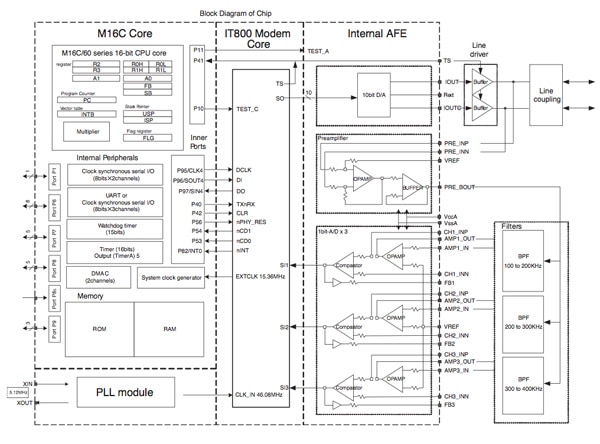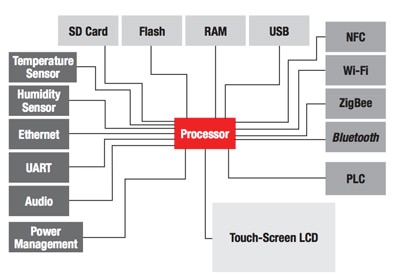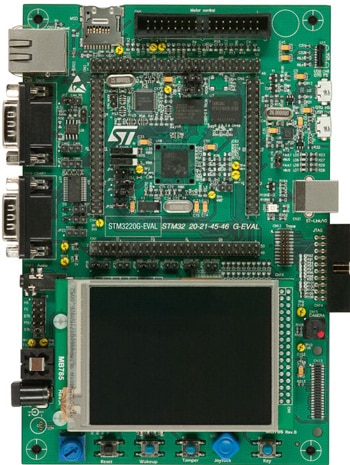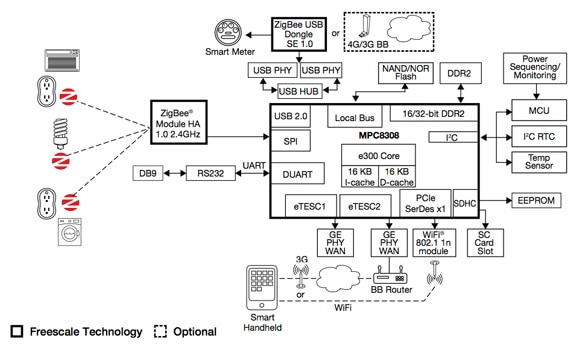How to Turn a Home into a Smarter Home
投稿人:DigiKey 欧洲编辑
2013-12-11
Building ‘smarts’ into offices and residences goes beyond adding an Internet connection and a Wi-Fi network. It requires a system-level approach to implementing automation, measurement, and security. Bringing all of these factors together will facilitate more efficient energy usage, as well as greater convenience for homeowners and office workers. However, there are many challenges that must be addressed, not least of which is the development and integration of entirely new functionality.
With demand growing from both the supplier and consumer sides, semiconductor manufacturers are now building the solutions and ecosystems necessary to make Smart Homes a reality. General-purpose microcontrollers offer the performance and configurability to gather and distribute the data needed to implement disseminated control underpinned by a centralized decision process - features that are fundamental to achieving the potential rewards available. This article looks at the system-level requirements and how they are being addressed.
What makes a HAN?
HAN, or Home Area Network, is the generic term used to describe any form of communication in and around the home. Arguably, it has been in use since the first dial-up connections were shared between home computers and connected to printers, but it really took hold with the advent of Wi-Fi and the availability of low-cost wireless access points (WAPs), which rapidly turned the concept of a home network into a reality for all consumers with a broadband connection.
The proliferation of internet connectivity around the home has also enabled emerging use-cases such as on-demand content consumption enabled through connected TVs, a trend that has negatively affected traditional markets including DVD rental. However, the tide of change will not be stopped. Internet connectivity is arguably still in its infancy when seen as a technology for connecting not just people, but objects too.
Projected figures are under constant revision, but it is widely anticipated there could be in excess of 20 billion connected devices by 2020, and many of those devices will be relatively simple, such as an intelligent light switch, door lock, or thermostat. Enabling the backbone for a connected society will ultimately be the domain of large service providers, but what happens inside the home, within the Home Area Network, is still very much an open market. Given the scope for connected devices, it is not surprising that there remains some confusion and competition when searching for a definitive solution; in reality, interoperability and extensibility will be key to the success of HANs and the Smart Home. In order to accommodate the level of interoperability needed, it is likely that the average HAN topology will feature at least one Gateway (or centralized control unit), and that the gateway will need to offer multiple forms of communication, such as ZigBee, Wi-Fi, and Power Line Communications.
Smart connections
Given its installed base, it seems reasonable to expect Wi-Fi to play a key role in HANs for Smart Homes, but it is still a relatively ‘heavy’ protocol, and as such would be suboptimal for many simple, connected end-points like an intelligent switch. For this kind of application, low-power wireless protocols like ZigBee and Z-Wave are more likely to proliferate.
However, in some cases, it may be necessary to supplement wireless connectivity with a wired alternative, and rather than install new cabling, such as CAT5 for Ethernet, many believe power-line communications (PLC) offers a better solution.
The main benefit of PLC is that it uses the existing power cabling for data transfer, using a robust protocol and modulation technique. There are several industry alliances supporting PLC for home area networks and Smart Homes, such as the G3-PLC Alliance. To support the use of PLC in this application area, Renesas has developed a single-chip 16-bit MCU with an integrated PLC modem PHY (physical layer) and AFE (analog front end), the M16C/6S.
The PHY featured in the M16C/6S series is the IT800 from Yitran, which uses a patented Differentiated Code Shift Keying (DCSK) modulation technique that complies with FCC, ARIB, and EN50065-1-CENELEC. It is capable of data rates as high as 7.5 kbit/s in Standard Mode (dropping to 0.625 kbit/s when used in compliance with CENELEC Extremely-Robust Mode). As well as being inherently immune to interference, provided by the DCSK modulation technique, the PHY also implements forward short-block soft-decoding error correction and special synchronization algorithms. The part is also supported by dedicated data-link layer firmware. Figure 1 shows a block diagram of the device in a typical application configuration.

Smart control
Of course, the whole point of a connected smart home is that it not only gathers information about its environment, but acts on that information. Distributed control will be necessary in order to effect not only automated management, but also remote control of our homes. One of the main ‘selling points’ for Smart Homes is that it will allow home-owners to ‘dial in’ to their homes, via their HAN, from any connected location in the world. This level of automated and remote control will dictate the need for ‘smart appliances’, and one way of achieving that is to retrofit the intelligence into points of supply such as light switches and mains supply sockets. Another way is to create a new generation of devices that completely supplant their ancestors, such as the Smart Thermostat.
Texas Instruments cites the Smart Thermostat as a target application for its Sitara™ family of ARM® Cortex™-A8-based processors, including the AM335x range. The same device can also form the basis for a Smart Gateway, providing multiple forms of connectivity. This may even take the form of a Smart Thermostat application, as shown in Figure 2, where several forms of wired and wireless connectivity are integrated alongside a number of sensors, used to provide the stimuli needed to make intelligent decisions about when to turn the heating and/or ventilation system on/off based on temperature, humidity, time of day, and even level of occupancy. This level of control may also rely on other intelligent sensors connected through the HAN, which may also be based on the AM3352 processor. For this reason, a high-level operating system is likely to be necessary, which brings its own demands in terms of the processor sub-system. Here the AM3352 excels, as it is capable of running Linux, Android, and Embedded Windows CE.

Smart feedback
The concept of using an otherwise everyday object, like a thermostat, as an integral part of a smart home network will become commonplace. The ability to use such devices to create mesh networks will help overcome possible communication problems caused by external elements, including building construction and physical distances between nodes. In addition, it is also anticipated that entirely new devices will emerge to provide new features, which may also act as ‘gateways’. One example is the in-home display.
STMicroelectronics has identified a need for gateways that can also display important or relevant data about the system to homeowners, both in the house and remotely. To achieve this, it is expected that devices like the in-home display may also integrate an HTTP gateway, effectively making them a web-server. In this way, they will be able to securely post system data on the Internet, allowing remote monitoring and control. ST has created an application note for an in-home display based on an evaluation kit (Figure 3) for its STM32 F2 processor.

An interesting feature of the STM32 F2, which is based on the ARM Cortex-M3 processor core, is the Adaptive Real-Time Memory Accelerator, which enables zero wait-state execution from Flash memory when the core is running at up to 120 MHz, allowing it to realize its full potential of 150 DMIPS. It achieves this by implementing an instruction prefetch queue and branch cache, which increases program execution speed from the 128-bit Flash memory. The performance achieved using the accelerator has been measured using the CoreMark benchmark to be equivalent to zero wait-state program execution from Flash memory at a CPU frequency of 120 MHz.
Smart access
As shown, an important element of the Smart Home, at least initially, will be its ability to integrate numerous point-solutions, which may be using an open standard protocol, such as ZigBee Home Automation, or a proprietary but dedicated protocol, such as Z-Wave, into a HAN.
Accommodating a wide number of protocols could rapidly become difficult to administer if all devices have unrestricted access to the network and beyond, and for this reason it is envisioned that a central ‘gateway’ will be given the responsibility of managing the link between nodes on the HAN, the utility (smart) meter, and the Internet.
Smart Gateways will take various forms. As mentioned, they may be an integral and functional part of the HAN, or they may be dedicated standalone devices. Freescale has identified a need for a solution here and has developed an evaluation kit that takes the form of a Networked Smart Gateway, based on its MPC8308 and the QorIQ P1010 processors. Figure 4 shows the MPC8308 in a Networked Smart Gateway application.

It is the gateway that will likely provide the crucial link to the Internet for remote control/monitoring, and as such will also be responsible, at the highest level, for network security. As a home is likely to feature several smart meters for different utilities, such as gas, electricity, and water, it will fall to the home gateway to reliably and efficiently manage the intercommunications between nodes on the home network and the smart meters. This is likely to require the sharing of data, so security will become an even higher priority than it is today.
Conclusion
With the advent of connected TVs and STBs, we have already welcomed the Internet into our homes via our appliances, albeit through predominantly one-way traffic today. In the near future it will become commonplace to be able to monitor and control our homes from anywhere, as long as we have access to an Internet connection; smartphones and a 3G/4G network are expected to become instrumental in this respect.
The infrastructure required to provide the connection to the home is already in place, it now relies on the development of home area networks that are secure and efficient in order to fully realize the Smart Home vision.
References:

免责声明:各个作者和/或论坛参与者在本网站发表的观点、看法和意见不代表 DigiKey 的观点、看法和意见,也不代表 DigiKey 官方政策。








